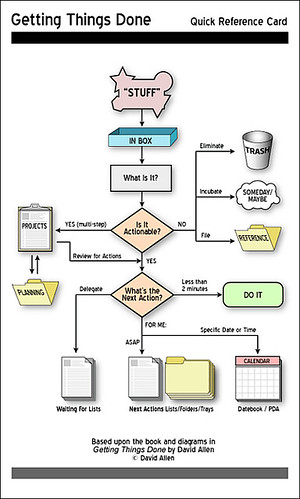
Well, I am now through with Chapter 2, entitled Getting Control of Your Life: The Five Stages Of Mastering Workflow. This chapter covers the five-stage method for managing workflow. These five stages are:
Collect
Process
Organize
Review
Do
-
- The Four-Criteria Model for Choosing Actions in the Moment
- The Threefold Model for Evaluating Daily Work
- The Six-Level Model for Reviewing Your Own Work
Lets take a look at each of these five stages.
Chapter 2 also introduces the GTD workflow diagram for the first time. This diagram is pretty fundamental to the whole GTD process and it is good to see it introduced at such an early stage in the book. From my reading, Chapter 2 seems to pretty much act as a feeder chapter, introducing the GTD methodology with later chapters expanding on the topic and theme of each of the 5 stages for managing workflow.
A full size version of this workflow can be found HERE.The first stage is Collect. This stage is concerned with how to collect what is termed as your “stuff”. Your stuff can be business and personal to do’s and tasks. This section really did interest me as it immediately became apparent that the whole GTD methodology is not about enforcing strict systematic controls onto you about how you do things, but more by guiding you into what you need to do, using whichever systems works for yourself. For example, there are multiple ways that people collect their “stuff”.
I have been an avid user of Microsoft Outlook for years and I have also used PlanPlus from FranklinCovey (I will cover this in a future post). Since moving to my beloved Mac, I have also started using Entourage on the Mac as my mail client, although I may move away from this after I finish the GTD book and start playing with some other GTD tools.I still use Outlook that runs my business email on a Parallels Virtual machine with Windows XP, as well as Entourage for personal tasks. Tasks in two places, great!. I am gadget crazy and have had PDA’s ever since they first emerged. I have also tried MDA’s from T-Mobile having the MDA2, MDA3, and MDA Pro.
I am quite strict about recording my tasks as they come into my head. I am quite a thinker and ideas guy and I can tell you that ideas and tasks pop into my head all the time, I am fortunate to be plagued with them!. Anyway, there is always the time when you do not have the PDA, or the PDA is dead and you end up with and open loop.The Collect part of Chapter 2 is about ensuring you have the adequate collection tools. Note the plural use of tools, rather than the singular tool. This is because the book tells you to use as many tools as it takes.Over the past few weeks, I have really converted to the HipsterPDA. This is a great GTD tool devised by Merlin Mann of 43Folders.com.
The version I am using is made from the fantastic PagePacker application. So now, I carry around a little A6 sized PDA with me. I also bought the Fisher Space Pen Bullet, as recommended by Merlin Mann. This PDA and pen goes with me wherever I go, and boy has it come in useful. I never thought I would see the day where I actually use a pen and paper to track tasks. I am not really focusing on my usage of the GTD methodology as that will come later, when I am through with the book.
The second stage is Process. It is the Process stage where you decide what to do with the tasks you have collected. I will not delve too much into this as I am sure there will be a lot to write about this after reading the next few chapters and Chapter 2 does only briefly cover the process ideas. The main idea is that you decide on the next action for the collected stuff. The main decision is whether the task is actionable or not.
The third stage is to Organize the stuff. When it has been processed, where are you going to record the next steps? Are you going to send the stuff to the trash, or are you going to defer it to a later date? these are all decisions that have to be made at the organize step.
The fourth stage is Review. This takes the form in the chapter of a weekly review where you look at the items you have collected and the next steps associated with them. Dave Allen states
For most people, the magic of workflow management is realized in the consistent use of the review stage.
The last stage is Do. This stage is about choosing when to do the actions you have set yourself. You are introduced to three models for making action choices. These are:
Each of these will be covered in some depth as they are quite complex and I will enjoy writing about these.
Well, off to make a start on Chapter 3. I will be back soon!